| Author |
Message |
|
Aleksei Sosnovski
|
 Posted: Tue 21 Feb, 2012 1:15 am Post subject: A story of one sword Posted: Tue 21 Feb, 2012 1:15 am Post subject: A story of one sword |
 |
|
Yesterday I had an unfortunate event that many of us are doomed to experience at some point. One of my favorite swords broke. I decided to write this post to provide some information to people who want to know about how swords break, what they can withstand and what is fatal for them.
A couple of years ago I ordered a Hanwei Tinker blunt bastard sword blade from Kult of Athena and made a hilt for it. The sword came out really well. Weighing only about 2lb 10oz it was easy to handle with either one or two hands yet due to light pommel it had enough blade presence do deliver powerful cuts. You can see this sword in my hand on top of this page http://www.myArmoury.com/talk/viewtopic.php?t...p;start=88. I liked this sword a lot but I used it very little because I have quite a few other swords much better suited for training and reenactment events. I actually used it only during about 5 or so training sessions, being careful not to block with the edge and so on.
One day I took the sword to a reenactment event (that was actually the main reason for making this sword: a weapon more decorated than an average reenactment sword that would match my better-made "knightly" armor among much cruder armors must reenactors have in my country). And it was the beginning of the end for the sword. At some point when I was delivering a cut my opponent made a static edge-to-edge block with his Hanwei practical single-hander and my sword received a nasty nick about 1/10" deep. The nick was rounded (U rather than V shaped) an I filed it to remove any potential stress points. I was surprised that the sword was nicked so deeply, but then it had really thin edge compared to Hanwei practicals.
Yesterday I took the sword for a training session. I was practicing some cuts with about 70% force on a pell (a single tyre hung on a rope). At some point I heard a loud "bang" and I immediately knew what happened. I have broken quite a few blades in the last 10 years so I know this sound very well. Last 6 inches of the blade broke off exactly at the nick. I inspected the broken cross section and did not see any signs of incorrect heat treatment. Just uniform fine-grained structure. After the sword received the nick I did expect it to break, but I did not expect it to break on a relatively light and soft pell, especially when I was not hitting with full force.
I suspect that the blade was not forged and/or heat treated very well. Maybe it was too britle and that caused the blade to get this deep nick and to break later. But I cannot be sure of it because I can't see any signs of cracking during heat treatment or large grain. I will experiment with the tip of the blade that broke off, maybe then I will be able to make a more educated guess.
The lessons learned are:
- while Hanwei Tinker blunts are a joy to handle, they represent a purely "civilian" weapon not intended to withstand prolonged fights. They require both fighters to use "correct" deflections and blocks with ones flat or they will not last at all. At least mine did not.
- A solid edge-on-edge block with a heavier "battlefield" sword can be a very good way to win against a lighter and faster "civilian" weapon.
What next? Well, I will probably order a sharp bastard sword blade and mount it to the hilt of the broken sword. Some more work to remove grinding signs on the pommel and to hide the nasty nut protruding from it and it would be an excellent piece equally suitable for display and for cutting softer targets. Actually I have been planning to do so for a long time because I like the hilt too much to let it be battered during training and reenactment events. But damn these taxes and shipping charges, I live too far from US :-( But the most important thing is that the sword is broken but not yet dead! As it is practically scratch- and nick-free I will sharpen the remaining part of the blade, grind a proper tip, shorten the tang, make a new hilt and it will become a somewhat short but feather-light and lightning-fast one-hander!
So the story of the sword continues...
|
|
   |
 |
|
Pauli Vennervirta
|
 Posted: Tue 21 Feb, 2012 3:31 am Post subject: Posted: Tue 21 Feb, 2012 3:31 am Post subject: |
 |
|
Sorry to hear about that. I have a couple of Hanwei-Tinker one hand sword blades. One is a normal blunt early medieval blade, the other used to be sharp. The blunt started getting nicked quite fast. A friend blunted the sharp one, taking a couple of millimeters off both edges. The result was much more durable than the original blunt, with nicely rounded edges.
I intend to use the blunted blade in studying I 33. So far it has worked nicely.
|
|
  |
 |
Johan Gemvik

|
 Posted: Tue 21 Feb, 2012 5:53 am Post subject: Posted: Tue 21 Feb, 2012 5:53 am Post subject: |
 |
|
This is sad, we like to think swords should not break on us but I know the feeling when they do.
First time one of my swords broke I got this cold chill down my spine hearing that sound, then seeing a blade fly off and stick in the ground quivering made me realise how dangerous swords breaking can be. That was a "cheap" wall hanger though, but back in those days that wall hanger cost me more than one of these tinker line bare blades today. But your story is also very interesting from a scientific viewpoint. How does a sword break and from what and how can we prevent it?
My guess is that the Tinker line sharps have a clearly higher temper in the edge and the blunt is simply annealed all over to a lower hardness while still being much thinner in the edge than most fully rebated blades. I've seen similar issues with other thin edged but blunt blades (i.e. older Del Tin and others).
I think Tinker Peirce designed it to be thin to feel like a real sharp for less dangerous initial cut form training just getting to know how it feels and moves while not cutting yourself on it, as well as to be used for low impact binds more than being fully steel on steel battle worthy. But this is just a guess. I still think it needs a tempered edge steel, all swords do, I don't know why so many blunts I've seen don't have that. You'll still get nicks of course, but it helps.
I've cut one of my viking tinker sharps into a cold rolled steel bar with no damage to the sword while leaving a visible nick in the bar, this is far more durability than I ever expected from a fairly low cost bare blade. Still, like all swords it can nick and break over time.
But all is not lost. What about making that broken off piece into something useful? A dagger perhaps? Everybody needs one of those. And one might be able to make a brokenback seax or even a small messer or Falchion out of the other piece.
"The Dwarf sees farther than the Giant when he has the giant's shoulder to mount on" -Coleridge
|
|
  |
 |
|
Aleksei Sosnovski
|
 Posted: Tue 21 Feb, 2012 6:09 am Post subject: Posted: Tue 21 Feb, 2012 6:09 am Post subject: |
 |
|
| Johan Gemvik wrote: |
My guess is that the Tinker line sharps have a clearly higher temper in the edge and the blunt is simply annealed all over to a lower hardness while still being much thinner in the edge than most fully rebated blades.
|
I don't think that the blade is soft. On the contrary, I have an impression that it is rather brittle than soft. Maybe this impression is incorrect, I will compare the point that broke off to my other swords.
| Johan Gemvik wrote: |
But all is not lost. What about making that broken off piece into something useful? A dagger perhaps? Everybody needs one of those. And one might be able to make a brokenback seax or even a small messer or Falchion out of the other piece.
|
That's just what I wrote: I'll turn it into a sharp one-hander. The piece that broke off is only about 6" (14 cm) so there is still plenty of blade left. Will be a good cutting tool for girls :-)
|
|
   |
 |
|
Ben Sweet
|
 Posted: Tue 21 Feb, 2012 8:16 am Post subject: Posted: Tue 21 Feb, 2012 8:16 am Post subject: |
 |
|
|
Can you post up photos of your broken sword to include close ups of the grain?
|
|
   |
 |
|
Aleksei Sosnovski
|
 Posted: Tue 21 Feb, 2012 9:55 am Post subject: Posted: Tue 21 Feb, 2012 9:55 am Post subject: |
 |
|
I have compared the blade to some of my kitchen knives and it seems to be equal to that of my Victorinox knife. So it is not soft at all, probably between 50 and 53 HRC. I have one knife that seems to be a little harder (cheap but actually very good) and another cheap but good knife that is obviously a little softer.
| Ben Sweet wrote: | | Can you post up photos of your broken sword to include close ups of the grain? |
Unfortunately I don't have a camera and if I took pictures with my mobile phone you would not be able to see anything. I can ask a friend to take pictures, but it will take a couple of days.
The metal has even medium-sized grain and is of light-gray color. I have seen both finer, "satin" grain and coarser, "rough sand paper" grain. Visually the grain is between that of 280 and 400 grit sand paper. The break is smooth and even, going in a very shallow arc from the nick to a place about 5mm closer to the hilt on the other edge. What I haven't paid attention to before is that the surface of the broken area about 0.5mm from both edges is dark gray. I have seen steel having visually different structures near the surfaces before but I don't know what causes it. Maybe it is just the result of the steel breaking, or a result of heat treatment (outer layers of a steel bar are cooled much faster). The only case when I saw black on a surface of a break was when the steel cracked during heat treatment, but it looked different from this blade. Either this blade had/developed very shallow cracks near both edges or it is simply an effect of forces applied in this direction when the sword broke. Or maybe the steel simply oxidized during the night, after all people were touching it. At least these darker areas are small enough for my not noticing them yesterday (if they were there at that time) and are not clearly recognizable as cracks.
|
|
   |
 |
|
Aleksei Sosnovski
|
 Posted: Wed 22 Feb, 2012 9:00 am Post subject: Posted: Wed 22 Feb, 2012 9:00 am Post subject: |
 |
|
OK, today I sharpened the broken blade. Took me about 1.5 hours, angle grinder with variable RPM can do wonders if you use right abrasives and do not hurry. Now the question is: what hilt should I make? Ideally I would like the sword to look appropriate for the first half of 15th century, preferably around 1430. Or maybe early 16th century with a hilt a bit more complex than a simple crossguard. But here is the problem: the blade does not look like anything I have seen on historical swords. The most similar blade that I have found is this:  (from here: http://www.myArmoury.com/feature_spotxii.html). It is short, only 70cm (27.5"), relatively narrow at the cross guard, cut-oriented though capable of delivering a strong thrust. The biggest problem is the fuller that ends only about 3.5" from the point. (from here: http://www.myArmoury.com/feature_spotxii.html). It is short, only 70cm (27.5"), relatively narrow at the cross guard, cut-oriented though capable of delivering a strong thrust. The biggest problem is the fuller that ends only about 3.5" from the point.
So I would like to hear your opinions. What hilt would suit such a blade best? Maybe you know a historical sword with a similar blade or maybe depictions of similar blades in historical art? Any input would be highly appreciated.
|
|
   |
 |
|
Nicholas A. Gaese
Location: Montreal, Quebec, Canada Joined: 06 Aug 2007
Posts: 100
|
 Posted: Wed 22 Feb, 2012 9:58 am Post subject: Posted: Wed 22 Feb, 2012 9:58 am Post subject: |
 |
|
I'd say say go with your original plan. When it comes to older rehilted or reshaped blades, its hard to match it to any typology. In any case your good so long as you place a younger hilt style to an older blade, and not the other way around.
Attached i've added a pic of an older type XVIII ish blade to affixed to a 16th century hilt. This could not be assigned to any typology as far as the whole sword is concerned, as far as I know (im not really good with the typologies, never got around to memorizing them).
Regards.
 Attachment: 34.98 KB Attachment: 34.98 KB
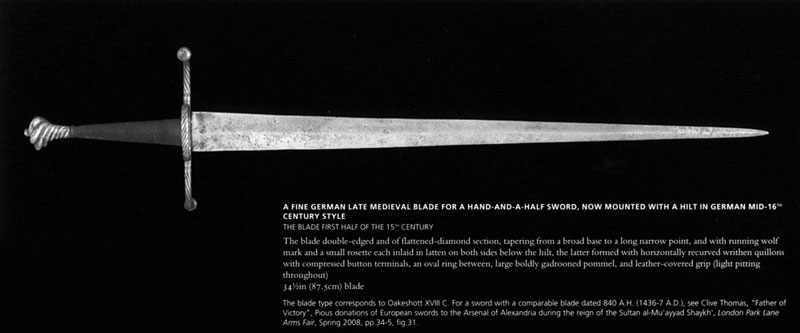
Last edited by Nicholas A. Gaese on Wed 22 Feb, 2012 11:57 am; edited 1 time in total
|
|
  |
 |
Paul Hansen

|
 Posted: Wed 22 Feb, 2012 11:21 am Post subject: Posted: Wed 22 Feb, 2012 11:21 am Post subject: |
 |
|
So the sword blade now looks like the one I just Photoshopped (see attachment)?
If so, just shorten the hilt and you have a more or less typical Type XII, or perhaps a Geibig type 9 or 13.
http://www.myArmoury.com/feature_geibig.html
 Attachment: 10.81 KB Attachment: 10.81 KB
[ Download ]
|
|
  |
 |
Johan Gemvik

|
 Posted: Wed 22 Feb, 2012 12:15 pm Post subject: Posted: Wed 22 Feb, 2012 12:15 pm Post subject: |
 |
|
Good idea Paul. At first I didn't know what to make of your model, but I get it now, it just shows the work in progress.
With some touches this can turn into a new really neat sword.
"The Dwarf sees farther than the Giant when he has the giant's shoulder to mount on" -Coleridge
|
|
  |
 |
|
Aleksei Sosnovski
|
 Posted: Wed 22 Feb, 2012 1:38 pm Post subject: Posted: Wed 22 Feb, 2012 1:38 pm Post subject: |
 |
|
| Paul Hansen wrote: | | So the sword blade now looks like the one I just Photoshopped (see attachment)? |
Exactly!
Since I'm not going to modify existing hilt (it is a custom longsword hilt with metal elements on handle so I will simply mount it with a sharp Hanwei Tinker bastard sword blade) I am free to make anything I want. I will probably go for a wheel pommel and a slightly curved crossguard to get something like this
 . .
Or maybe try a scent stopper or fish tail pommel? Hmmm, I think I have to spend some time examining all the historical illustrations that I can find for period between 1350 and 1450.
|
|
   |
 |
|
Aleksei Sosnovski
|
 Posted: Wed 29 Feb, 2012 6:37 am Post subject: Posted: Wed 29 Feb, 2012 6:37 am Post subject: |
 |
|
OK, I finally managed to take pictures of the broken tip. I am now pretty sure that manufacturing process was flawed in some way. Maybe not critically flawed, but the sword could have been made tougher. The grain is noticeably larger than on the steel that I heat treated myself. Grain growth can be caused by
- using too high temperature for quenching
- holding the steel at quenching temperature for too long
- not properly normalizing steel or overheating the steel during normalization after forging (as far as I remember these blades are forged).
Any of the above-mentioned is a flaw in the manufacturing process.
The dark area near the edge that is barely visible on one of the attached photos but is more obvious in reality remains a total mystery to me. As far as I remember these blades are marquenched and this process greatly reduces the chances of cracking during quenching. But it is still possible if the steel was overheated. Micro cracks can also develop during forging if the steel is hammered cold.
Since I am not very familiar with marquenching (don't have facilities to do it myself anyway) and metalworking is my hobby, not a profession, please correct me if I made a mistake in my conclusions.
 Attachment: 70.02 KB Attachment: 70.02 KB
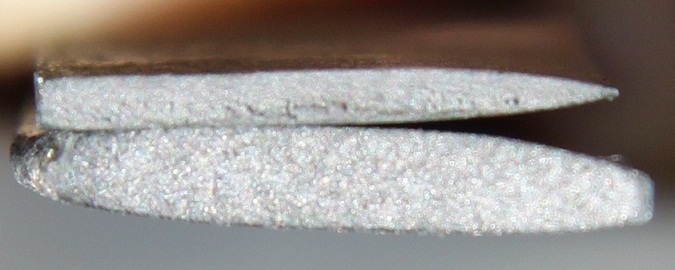
Break area compared to a piece of metal that I heat treated myself and broke as an experiment several months ago. I think it is quite obvious that the grain on my piece is much finer than on the sword though I didn't normalize it before quenching
 Attachment: 67.3 KB Attachment: 67.3 KB
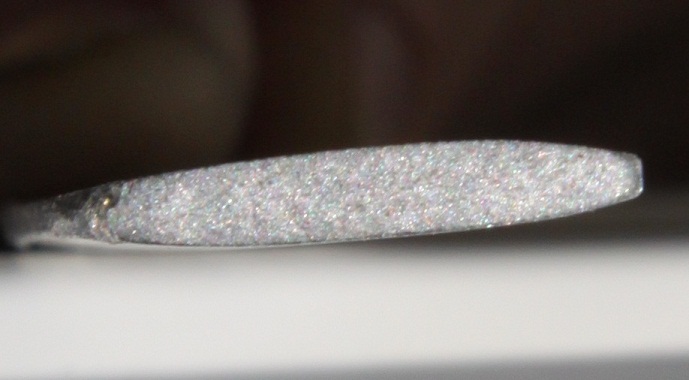
The darker area near the edge (right edge on the photo). It was very difficult to make it even barely visible on the photo, but in reality it is more obvious.
 Attachment: 72.91 KB Attachment: 72.91 KB
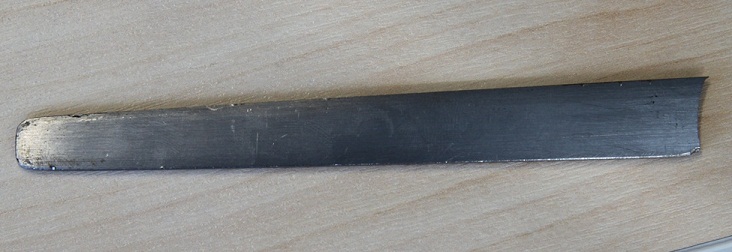
Broken tip. No deep nicks except the one that caused the break, only very shallow ones and scratches.
Last edited by Aleksei Sosnovski on Wed 29 Feb, 2012 6:54 am; edited 2 times in total
|
|
   |
 |
|
Aleksei Sosnovski
|
 Posted: Wed 29 Feb, 2012 6:43 am Post subject: Posted: Wed 29 Feb, 2012 6:43 am Post subject: |
 |
|
And for comparison two of my old broken sword-like crowbars a.k.a. training swords. These had crossguards welded on (yes, many years ago I learned blade making the hard way) which caused them to break. These images were reduced in size so don't compare grain size to the ones from my previous post. What is clearly visible that the break areas are very uneven compared to ones you can see in my previous post.
 Attachment: 68.02 KB Attachment: 68.02 KB
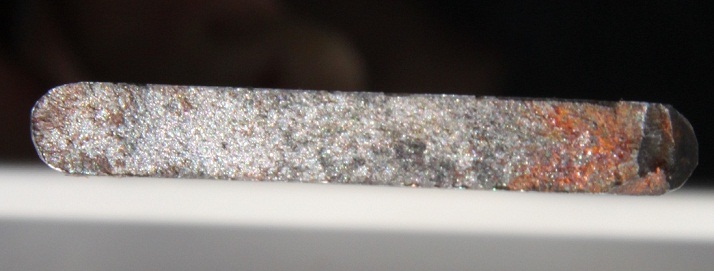
First old broken sword
 Attachment: 52.37 KB Attachment: 52.37 KB
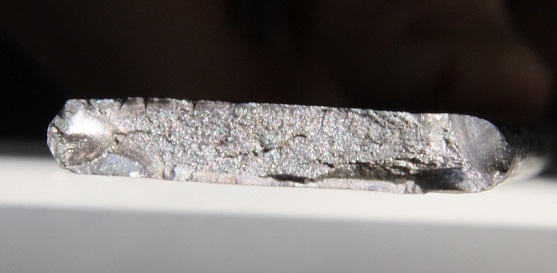
Second old broken sword. Welds are clearly visible.
|
|
   |
 |
|
Aleksei Sosnovski
|
 Posted: Wed 29 Feb, 2012 6:51 am Post subject: Posted: Wed 29 Feb, 2012 6:51 am Post subject: |
 |
|
And a few photos of the the sharpened blade.
 Attachment: 55.58 KB Attachment: 55.58 KB
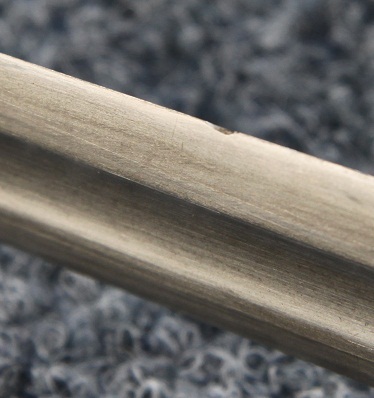
Same nick from another angle
 Attachment: 66.79 KB Attachment: 66.79 KB
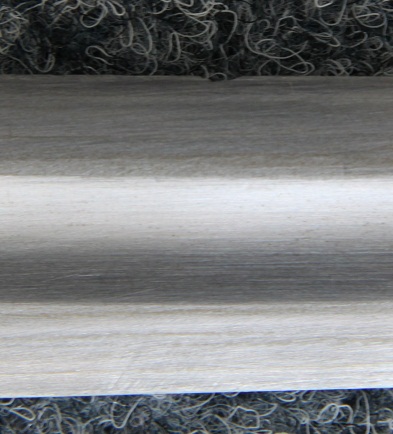
Deepest nick. I didn't grind any nicks away, there were simply no other nicks deeper than 0.1..0.2 mm. Only the one that caused the sword to break and this one.
 Attachment: 83.82 KB Attachment: 83.82 KB
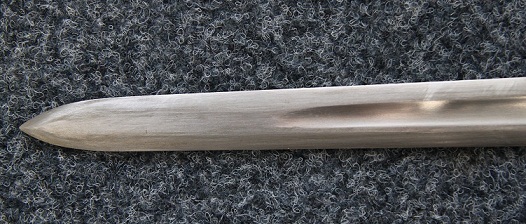
The point
 Attachment: 80.41 KB Attachment: 80.41 KB

The blade. Looks ridiculous with a longsword grip.
|
|
   |
 |
Jean Thibodeau

|
 Posted: Wed 29 Feb, 2012 8:10 am Post subject: Posted: Wed 29 Feb, 2012 8:10 am Post subject: |
 |
|
Should look good as a one hander with a shorter tang and maybe a different pommel style.
If the heat treating flaw was concentrated at the place the blade broke maybe the rest of it is sound ?
Could that dark spot be some sort of inclusion or impurity in the steel that may have acted as a stress riser ?
You can easily give up your freedom. You have to fight hard to get it back!
|
|
  |
 |
|
Aleksei Sosnovski
|
 Posted: Wed 29 Feb, 2012 8:25 am Post subject: Posted: Wed 29 Feb, 2012 8:25 am Post subject: |
 |
|
| Jean Thibodeau wrote: | Should look good as a one hander with a shorter tang and maybe a different pommel style.
If the heat treating flaw was concentrated at the place the blade broke maybe the rest of it is sound ?
Could that dark spot be some sort of inclusion or impurity in the steel that may have acted as a stress riser ? |
I was thinking of a wheel pommel and a curved crossguard. Should be a nice "civilian" sword, light and easy to carry around. For me making a crossguard is a piece of cake compared to making a pommel.
I do hope it doesn't break on me when I will be cutting with it. Anyway it broke quite close to the tip where it was narrow and thin. Obviously the remaining part of the blade is wider and thicker and thus is less prone to breaking.
Actually it could, haven't thought of this possibility. But without a proper analysis one can't be sure.
It's very frustrating when a barely used sword breaks because of one nick. If it hasn't been 2 years since I bought the blade I would probably have contacted the seller. It is very inspiring though when a broken blade can be reground and reused. I hope the sword will live longer in its new incarnation.
|
|
   |
 |
Luka Borscak

|
 Posted: Wed 29 Feb, 2012 8:41 am Post subject: Posted: Wed 29 Feb, 2012 8:41 am Post subject: |
 |
|
|
I guess there is less chance that sword will break while cutting optimal targets than what you used it for before.
|
|
  |
 |
|
|

